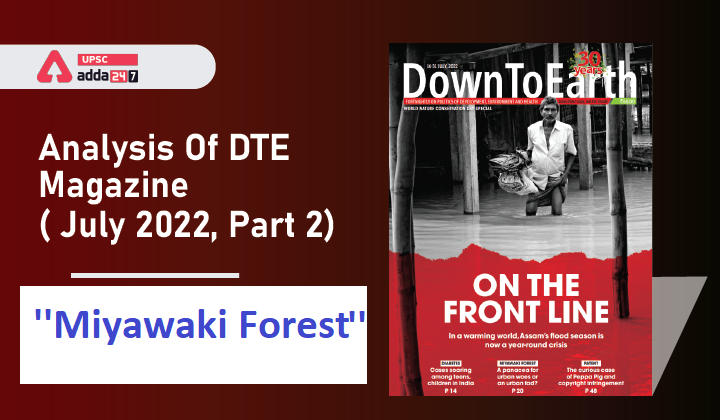Table of Contents
Down To Earth Magazine is a fortnightly magazine focusing on politics of environment and development, published in New Delhi, India.
UPSC Previous years’ questions on Development, Environment, Health and Disaster Management give us a clear idea about the increased importance of Down To Earth Magazine.
Down To Earth Magazine is one of the most important and indispensable source for UPSC Civil Services Exam Preparation. Keeping this in mind, here, we come with ”Gist Of Down To Earth Magazine” which covers important environmental current affairs articles in smooth pointed form, keeping in mind the demand of UPSC aspirants.
”Miyawaki Forest”: Introduction
- So far, nearly 200 Miyawaki forests have been set up across the country in the past decade.
- Miyawaki forests are springing up across Indian cities.
- Whether they are a way to restore urban biodiversity or just a quick-fix to achieve greenery is the biggest question so far.
”Miyawaki Forest”: What is Miyawaki Forest?
- Miyawaki is the dense urban forest which ia created following a method propounded by Japanese botanist Akira Miyawaki in the 1980s.
- The method essentially compresses layers of a forest—biomass, tree numbers and canopy spread—to fit on a small patch of land and also reduces the time taken for it to grow.
- For instance, under the method, saplings are planted with a gap of 30 cm against the conventional practice where the gap between two saplings is 2.4 m. Such dense plantation induces competition among the trees for sunlight, which then grow taller to avoid being shaded by others.
- As per an estimation by Miyawaki, who has created 1,500 such forests across Japan, India, South East Asia and Brazil, trees in a dense plantation grow 10 times faster than most other plants and result in 30 times denser vegetation in just two to three years.
”Miyawaki Forest”: Key Benefits
- In theory, the method offers a holistic solution to several urban woes, including the heat island effect, air and noise pollution and land crunch for greenery.
- This afforestation method is fast gaining attention across the country, from civic bodies and forest department officials to private groups and non-profits.
- The biggest achievement of the Miyawaki method is that it could bring back the forest that would have existed before human interventions. It would also reduce the heat island effect by several degrees.
- In cities like Bengaluru, Chennai and Hyderabad that are cramped with concrete jungle, Miyawaki forests are a great way of not only achieving quick greenery but also mitigating carbon emissions, purifying air with more oxygen and restoring soil and biodiversity.
- Miyawaki technique is an effective solution for rural places like Punjab, which has less forest cover.
”Miyawaki Forest”: Are they equivalent to natural forests?
- Miyawaki plantation does not fit the definition of natural forest, especially in India, which has hundreds of forest types spread across geographies.
- The forest formation process is slow as trees grow at their pace, enabling the soil conditions to change, microbes, earthworms and insects to flourish and host a wide range of biodiversity.
- A natural forest also allows a food chain to be established. Such is not the case with Miyawaki technique.
- So, it will take time to understand long-term effects of Miyawaki forests on ecology.
”Miyawaki Forest”: Can It Restore Soil?
- Miyawaki is the best solution to bring back nutrients and life to the soil, damaged by excessive use of pesticides and insecticides during farming.
- The technique helps regenerate and reforest farmland that has lost its productivity from decades of chemical-intensive practices.
- In case of a drought or intense condition, Miyawaki forests in arid areas can become more susceptible to catching fire. In such a scenario, all the carbon captured by the plants will go up in smoke along with the immense amount of water and money invested in the forest.
- A degrading land can start taking shape by hosting biodiversity in three to five years and sequester more carbon, which is the objective of tree plantation.



 TSPSC Group 1 Question Paper 2024, Downl...
TSPSC Group 1 Question Paper 2024, Downl...
 TSPSC Group 1 Answer key 2024 Out, Downl...
TSPSC Group 1 Answer key 2024 Out, Downl...
 UPSC Prelims 2024 Question Paper, Downlo...
UPSC Prelims 2024 Question Paper, Downlo...
